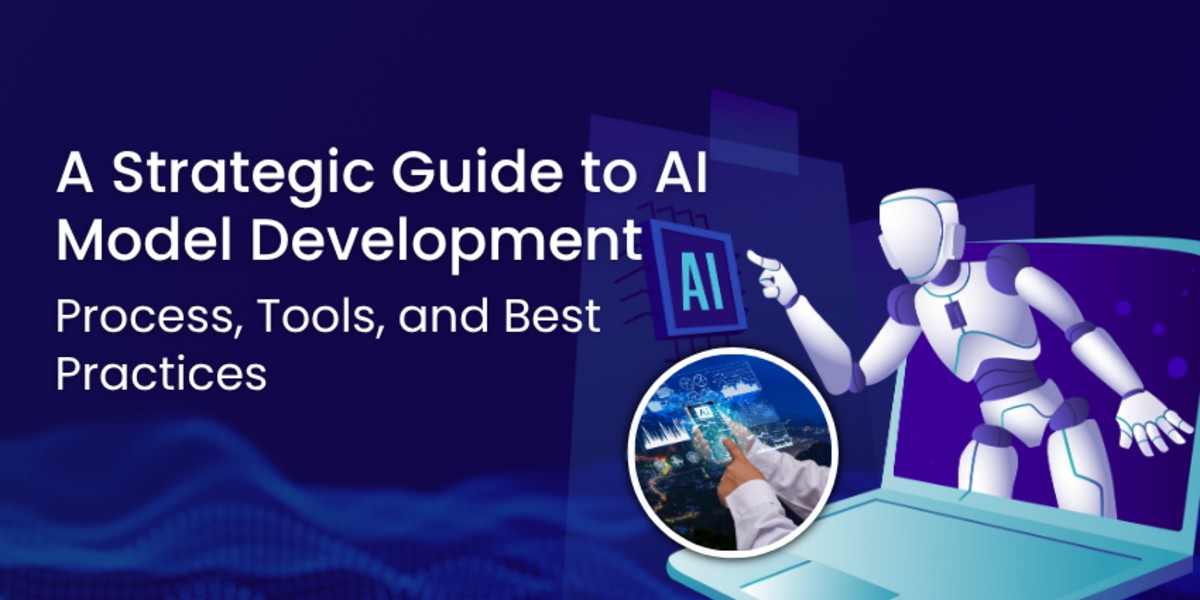A Strategic Guide to AI Model Development: Process, Tools, and Best Practices
- By James Thomas
- 27-10-2025
- Artificial Intelligence

Artificial Intelligence is one of the most rapidly spreading spheres that alters how business is conducted in any particular industry. AI can enable organizations to be more productive, cost-efficient, and able to offer smarter solutions since it can automate workflows and also provide real-time insights. The reason behind this transformation is the creation of AI models, or the process based on which machines might gain some knowledge by analyzing the data and making decent decisions.
The code is not the only thing involved in AI models. It includes the strategic and iterative problem definition, data preparation, model training, evaluation, deployment, and continuous monitoring. Every move must be planned well, have the appropriate tools as well, and feed into the business objectives so that the model goes beyond the classroom.
Here, we are going to take a closer look at the complete cycle of AI model development, along with the major tools utilized at each development phase, and best practices that should be adopted to create scalable AI models that will deliver the desired results.
What Is AI Model Development?
The process of designing the AI models is the process that involves forming machine learning (ML) or deep learning (DL) models with the ability to study patterns, categorize information, or make predictions with the help of large pools of data. These models are learned with the help of algorithms that enable them to learn better with time since they get fed more information.
Different applications, including chatbots and recommendation engines, fraud detection, and medical diagnosis, are supported by any AI model. These are some of the main applications of AI-powered automation, where development stages include describing a problem, processing information to train a model, deploying, and tracking.
Creating a successful AI model is not all about the code; there is also strategic planning, which involves having the right tools and achieving responsible AI practices.
Step-by-Step Process to Develop an AI Model
The development of the AI models is carried out in several steps. This is a step-by-step breakdown. Each step is based on the other in order to diminish risk and obtain a better accuracy. Be small in the beginning, move fast, and repeat with actual data and feedback. Align every level with the metrics, resources and business objectives.
1. Define the Problem Clearly
You must know exactly the problem that you are solving before approaching the process of developing a model. There is the understanding of the business goal, identification of success factors, and alignment to overall objectives to prevent wastages of time and resources.
2. Collect and Prepare the Data
Once the problem is defined, one would have to gather the proper data with the assistance of reliable means of data like databases, APIs, etc. To have a model that learns effectively and without bias, clean, organise, label and then partition into training, validation and test.
3. Choose the Right Algorithm
The selection of an algorithm also varies with the type of problem, like a classification or regression problem. Begin by using a simpler model and performing an evaluation that is done within a short time using the simpler model, and then scale it to a rather complex model, such as the neural network, as your knowledge and requirements increase.
4. Train the Model
In this step, the model is trained using the training dataset by tuning some internal parameters. The length of model training is reliant on the quantity, complexity of data, and computing power. Calibrating the appropriate number of hyperparameters is decisive for stable and effective training.
5. Evaluate Model Performance
The model is trained, and then its accuracy is measured against unseen data. The important measures included precision, recall, and error rates that will determine the quality of the model. Unfavorable outcomes mean that data editing or better model design is demanded.
6. Optimize and Tune the Model
Optimization refers to refining hyperparameters in order to optimize the performance of the model. These methods involve grid search, regularization, and cross-validation. This is done to achieve a model that would do well on new data without overfitting and underfitting.
7. Deploy the Model
Once the model is optimised, it may be applied to the production ecosystem, using APIs or cloud offers. Deployment must have the capacity to allow reliability and efficient scaling to enable the model to be run and integrated in real time with others that are already in use or set to be adopted.
8. Monitor and Maintain
Once deployed, monitoring of the model should be done continuously. The real-world observation can get out of the training set over time. Constantly monitoring, re-training, and checking improve model accuracy and avoid unpredictable system functioning.
Benefits of AI Model Development
The development of AI models is beneficial to organizations in a variety of ways besides automation. It can be used strategically and change operations and open new horizons.
1. Higher Efficiency and Productivity
Areas that can be completed on repetitive tasks include data entry, quality checks, and reporting, which can be carried out through AI models. This will allow the employees to engage more in value-added, employing human judgment.
2. Faster and Smarter Decisions
AI models are capable of manipulating large volumes of data within a few seconds, thus helping all businesses to differentiate patterns, forecast future requirements, and streamline processes to make swift, more reliable, and assured decision-making in rapidly changing marketing environments.
3. Cost Savings
Initial investments may be very expensive, however, in the long run, investment in AI models is cost-effective since they automate processes and forecast outcomes, which reduces expensive errors.
4. Competitive Advantage
Tailor-made AI models that pertain to business requirements can provide business-specific functionalities that are difficult to mimic by competitors.
5. Scalability
AI models deployed can be expanded into processing more data and serving more users, or can integrate more systems without requiring much heavy development.
6. Better Customer Experience
The services and products can be personalized, products could be recommended, and immediate customer support is possible with AI models, as well as a chatbot, increasing customer satisfaction and loyalty.
Essential Tools for AI Model Development
Different stages of AI development call for different tools. Here's a breakdown by category:
- Pandas: Arrays that are easily applicable in managing and reviewing information.
- OpenRefine: It is best suited to clean up dirty or poorly consistent tabular data.
- Apache Kafka: A distributed event logging system and data pipeline, and streaming application.
- Matplotlib: a fundamental Python library used in the production of static, animated, and interactive figures.
- Seaborn: Seaborn is based on Matplotlib to create sexier and more informative statistical figures.
- Plotly: Enables web-based and interactive plots, good when using dashboard and reports.
- Jupyter Notebooks: An interactive programming environment to examine, plot, and describe information.
- Scikit-learn: Library of conventional machine learning algorithms and performance estimation in general.
- TensorFlow: A Scalable and deployment-optimized deep learning framework that is open-source.
- PyTorch: PyTorch is a research framework that supports and is able to implement research and rapid prototyping in deep learning.
These tools can be stacked depending on your stack, use case, and scope of operation.
Best Practices for Building Effective AI Models
Best practices allow for minimizing your failure rates and the success of your AI initiatives. The following are some important tips to be observed:
1. Scale After Start
Based on a small pilot project, test ideas, run fast on insufficient data, validate findings, and then scale the entire operations up when effectiveness has been established to achieve efficiency.
2. More about Data
The complex algorithm does not win over high-quality data. Set aside time to explore, clean, and feature engineer the data in order to maximize precision, robustness of the model, and confidence in usage across different situations.
3. Avoid Over-fitting
The power of generalization of a model is penalized in over-fitting. Try regularization, cross-validation, and dropout layers so that performance does not go berserk when your model is applied to sets of data previously not used in production.
4. Get Domain Experts On-board
Engage a business expert early. They facilitate the interpretation of the outputs of models, clarity of problem relevance, and give critical information that is used to guide model modifications toward business and a greater level of accuracy.
5. Model Explainability
Use the tools of interpretability, such as SHAP or LIME, to explain the predictions. This leads to more transparency, user trust, as well as regulatory compliance, where there is a sensitive industry such as finance, healthcare, and other areas.
6. Emphasis on Ethics and Bias Removal
Data and models should be regularly tested to be sure they are not biased. Implementing bias detection and mitigation methods during the development of models will allow promoting fairness between users, inclusiveness, and avoiding a discriminatory trend.
7. Automate the Pipeline
Pre-loading, training, decohs & deployment via MLOps. Automation increases the efficiency of the work, reduces the occurrence of errors, an efficient and repetitive nature of work, and a scalable enterprise application.
Challenges in AI Model Development and How to Solve Them
The creation of AI models is one of the most promising fields of development and efficiency, however, it must obstacle some issues to become effective and achieve its potential. Therefore, strategic planning, application of excellent tools, and cooperation are the main factors.
1. Availability of Data Quality
Challenge: AI models need good quality data with proper labeling to work properly. Poor results can be a result of incomplete, outdated, and biased data.
Solution: Make substantial investments in proper data collection and procedures for cleaning the data. Clean using such tools as OpenRefine and make sure a dataset reflects real-world conditions.
2. Talent Shortage
Challenge: The workforce is highly likely to need skilled AI specialists, and it is financially consuming to recruit.
Solution: Partner with well-established AI development companies, or, where applicable, leverage pre-processed models, in order to reduce the skills gap.
3. Development Costs
Risk: Training custom AIs may be costly to install computing power, personnel, and time.
Answer: Initiate pilot projects so you can test ideas first and then scale. Host AI services on the cloud to cut down expenses on infrastructure.
4. Model Interpretability
Risks: Most of the modern artificial intelligence algorithms are believed to be black boxes, as it is not easy to interpret their decisions.
Solution: Use explainability tools such as SHAP or LIME and increase transparency and trust.
5. Security and Compliance
Risk: AI models are exposed to the possibility of adversarial attacks and may experience challenges posed by the dynamic regulation, as well as being subjected to legal or reputational risks.
Solution: Embrace robust cybersecurity measures, carry out continuous auditing, and follow the best AI governance approaches used across multiple regions in the world in order to safeguard data integrity and trust in businesses.
Future of AI Model Development
The primary areas of future developments of such an AI will be automation, ethical AI, and domain-specific tailoring. Organizations want models rolled out faster; thus, tools such as AutoML and MLOps will reduce the amount of work required to roll out models, making it fast and accessible to organizations of different sizes.
Ethics, including the identification of bias, fairness, and transparency, will emerge as the key pillars of AI development projects. Such practices will inform the willingness to comply, build trust, and make AI solutions acceptable to all user groups without bias in favor of some groups concerning their expectations about AI and technical perfection.
Conclusion
The modeling of an AI is a strategic process that is a blend of technical capability and business experience, as well as responsible practices. An adequate custom AI model development lifecycle will assist you in leveraging and accessing the full potential of robust models, which will deliver real value to you, i.e., the statement of problem, data preparation, training, deployment, and monitoring the model.
The key to long-term success in the Cloud-based AI environment is the ability to select the right tools, comply with such standards as explainability and scalability, and be adaptable to emerging technologies, business requirements, and regulation.



.jpg)
.jpg)
